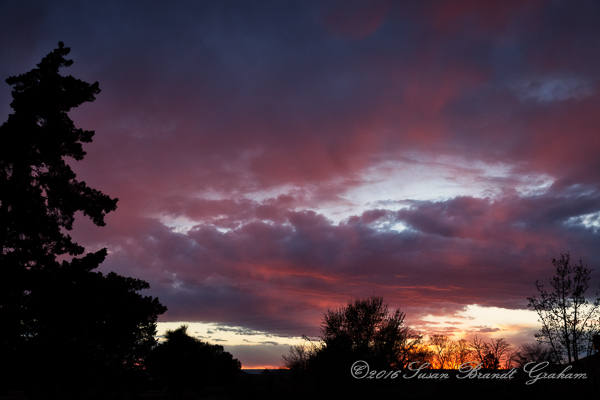Summer Sunset: December Thoughts
This summer sunset was actually the view looking east. A storm was approaching over the Sandia Mountains. Now, in December, it strikes me as particularly beautiful, and I want to share it.
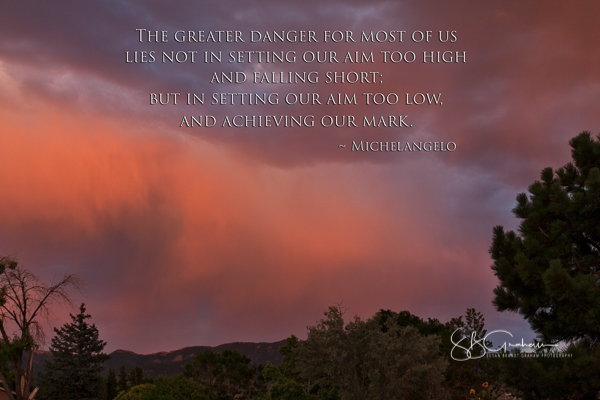
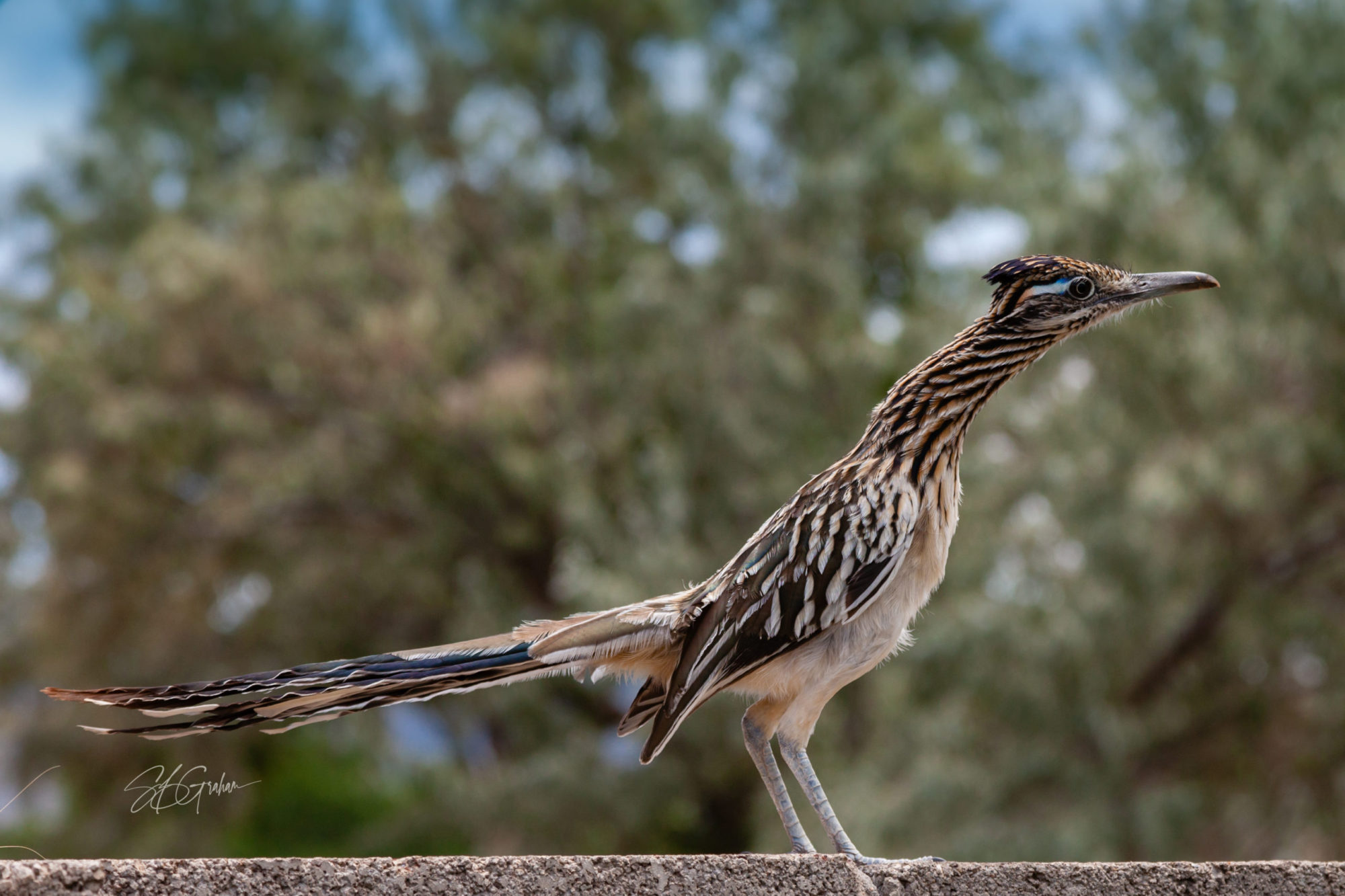
Susan Brandt Graham Photography
Life from a Southwest Point of View
This summer sunset was actually the view looking east. A storm was approaching over the Sandia Mountains. Now, in December, it strikes me as particularly beautiful, and I want to share it.

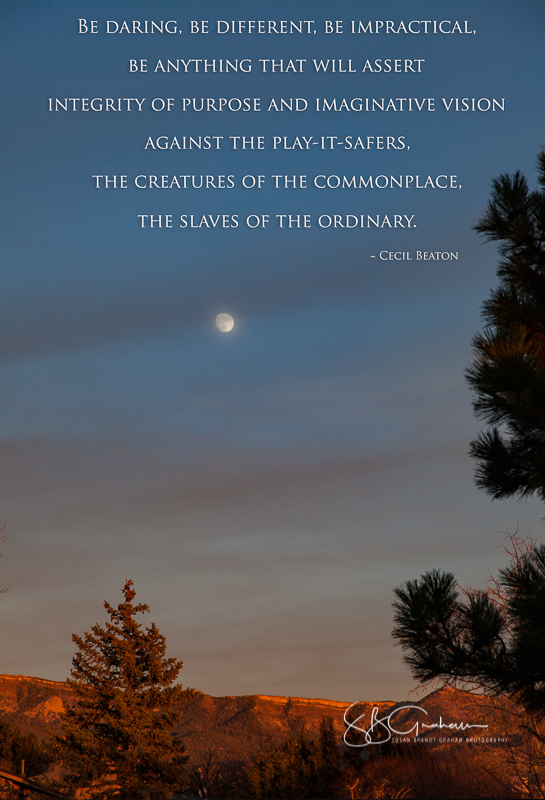
The supermoon of December 2016 is not quite as impressive as November’s. However, it would take an expert in moons to really be able to tell that with the naked eye, at least in the waxing phase.
Full moon will take place on December 13. Here in Albuquerque, moonrise is set for 5:09pm. But, about another 30 minutes or so is required for the moon to clear the mountains. The sky will be dark for the full moonrise. Photographing moonrise in daylight is so much more fun. The alpenglow on the Sandia Mountains at sunset, combined with a very bright waxing moon, was too beautiful not to photograph and share.
I hope you can see the moon where you are in the next few days.
Super Moon with Blue and Golden Hours of dawn, November 15, 2016 was a beautiful start to the day.
I had not intended to photograph the Super Moon this morning (Tuesday) because I had an early morning appointment for which I had to get ready. But that did not stop me from going out to see how the moon looked today. It was beautiful, as it had been in previous days. I did not have time to set up the tripod and shoot a series, although it would have been nice. I grabbed my camera, took a deep breath, and said to myself, “you can hand hold this for a few images.”
This first image is from 6:39 am MST, during “Blue Hour.” It is never an actual hour in most places. It is the time when the sun is below the horizon, either before dawn or after sunset, when the indirect sunlight has a predominantly blue hue. You can clearly see that in this first image.
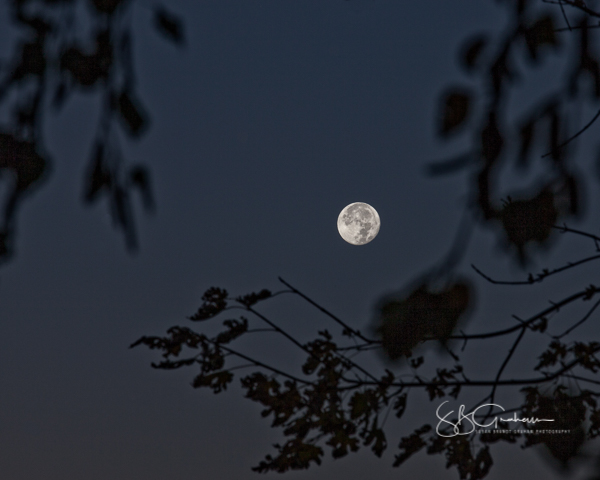
This second image was taken at 6:47 am MST, just 8 minutes later. This is transition from “Blue Hour” into “Golden Hour.”
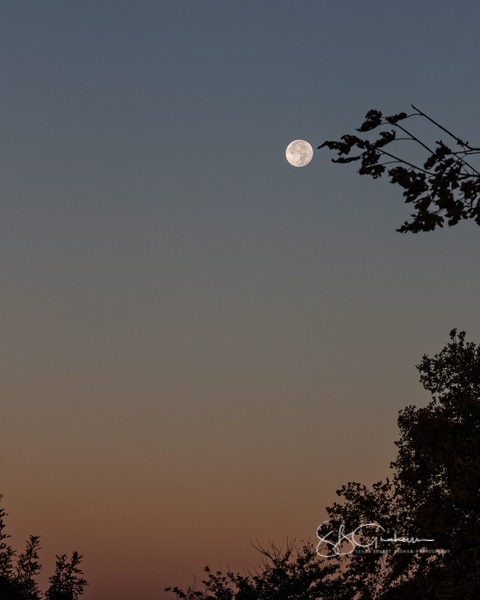
I’ve always been a fan of “Golden Hour,” because it is such flattering light, not only to people but also to landscapes. The moon looks pretty good at Blue Hour. 🙂 I think in the coming year I’ll try to practice more Blue Hour photography, just for fun.
This Super Moon has provided days of fun!
Super moon this November has been spectacular, even in the afternoon hours. Saturday I photographed the moonrise over the Sandias, partly because it was so beautiful, and partly because I wanted to prepare for photographing tonight (Sunday, November 13). I’m really glad I have the images from Saturday. You have seen the animated gif already, and this is a black and white of the moon on Saturday night.
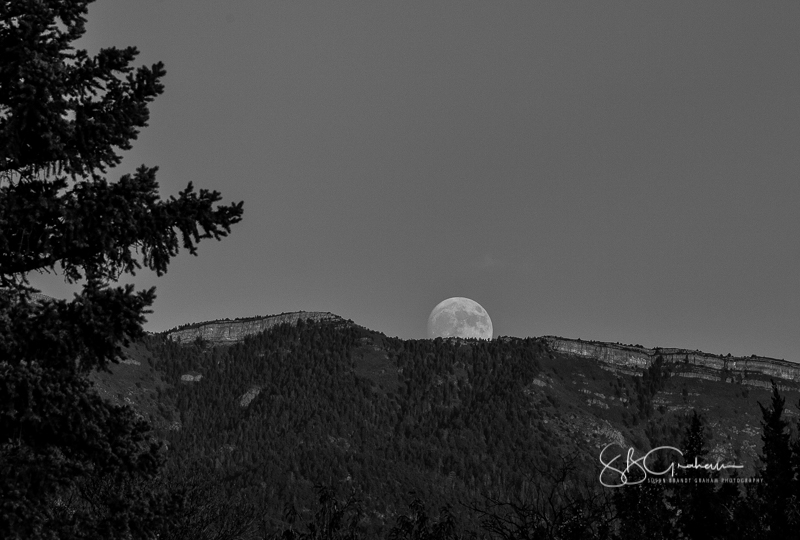
Late Sunday afternoon I set up my tripod, and got the camera set in such a way that I would be able to make final adjustments quickly when the moon rose. From where I live in Albuquerque, moonrise is never at the time the Tables say, because the moon has to clear the Sandia Mountains and not the horizon before becoming visible. I knew a lot of light would not be left by the time the moon actually appeared, but I had hoped for some. However, I was more disappointed than surprised when it was dark.
I was even more surprised by where the moon finally appeared. I was expecting relatively close to where you see it in the image above. That is not where it rose!!! Rather, it rose to the left of that tree, in between the tree and a neighbor’s swamp cooler. This was a learning experience. I moved the tripod and adjusted the camera settings. Because I had so much fun making an animated gif yesterday, I took a series for another gif. Then I made images specifically for the close-to-full (99.6%) moon.

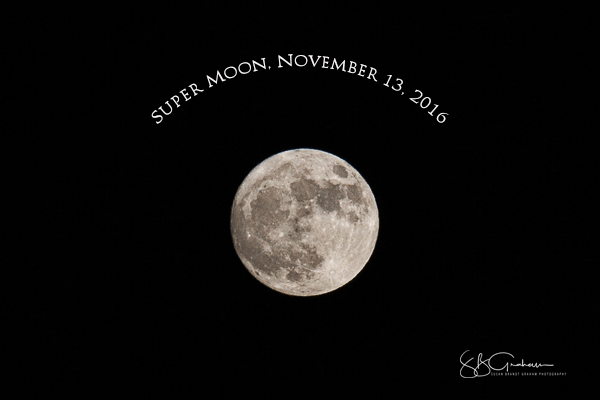
Because this moon was to be its largest near dawn of Monday, November 14, I got up to see what was visible. It was still dark. At 6:11 am MST I was able to get this clear shot. Note the slightly orange color as the moon is closer to the horizon.
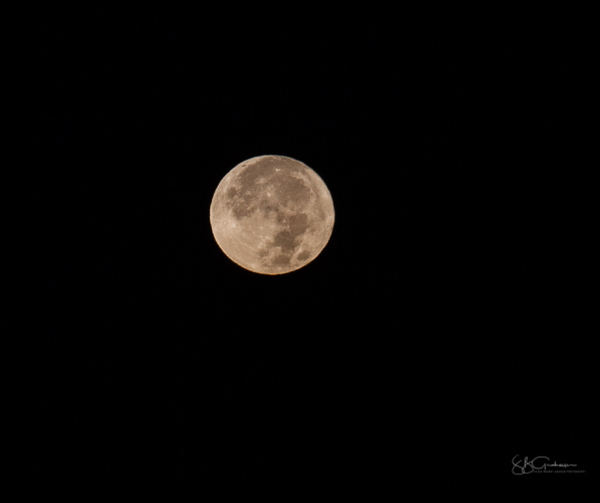
I have been reminded with this moon how quickly the light changes at sunset and sunrise. I’ve known that, but was definitely reminded! The images in this gif were made between 6:19 and 6:26 am, MST. There was no way to avoid seeing the moon through neighborhood trees from my home. It was still fun to make a gif.
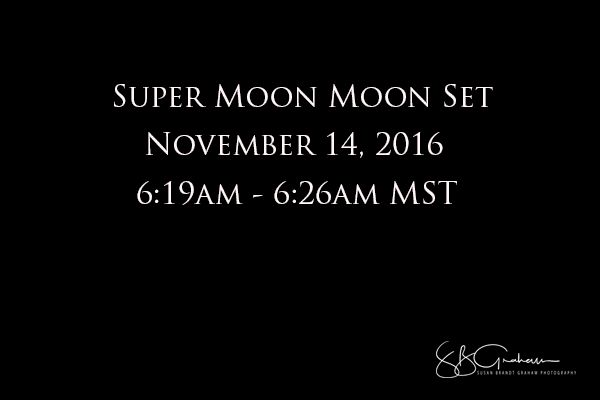
I hope you have enjoyed three days of the November 2016 Super Moon as much as I have enjoyed sharing it with you.
Prelude to a full super moon – what does that mean, anyway? Shortly after 6:00 am on November 14, the “largest” moon between now and 2034 will officially be “full.” The largest this moon will appear at moonrise will be tomorrow, November 13. Some of us who have photographed various moon phenomena find ourselves a little bored with just a bright full moon against a dark sky. Moonrise tommorrow will happen in light. It will be dusk, but not dark. For photographers, that presents an exciting challenge. Today I decided to practice with a series. All the camera settings are the same in this series. The images were photographed from 4:39 pm to 5:00 pm MST. Notice the changing light on the Sandia Mountains. A couple of frames have birds flying through; I left them. I hope you enjoy this “night before the night before the morning of…” in gif format. It loads slowly, and then repeats at normal speed.
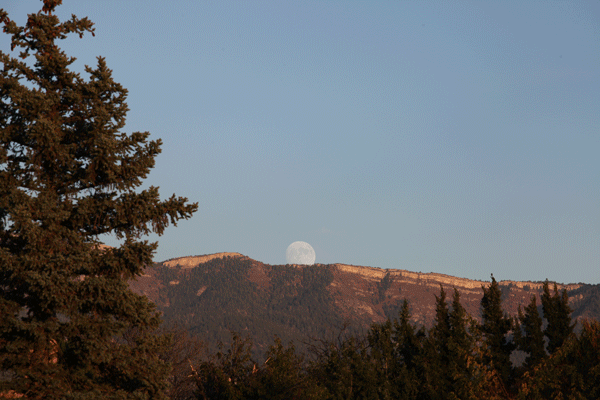
You can use this link to find moonrise times for your location.
November Moon – so many thoughts come to mind. I was aware the year’s largest Super Moon will be full on November 14, but will rise the largest on November 13. Yesterday, November 10, driving home around 3:00 or 4:00, I noticed the moon was well above the Sandia Mountains, and still appeared HUGE in the daylight. I did not get a photograph yesterday, but friend Tim Price posted a fabulous shot on his blog.
Today I made a point of being home in the late afternoon. I wanted to try to photograph the moon in daylight over the mountains and fall foliage. Have I ever said how much I love New Mexico?
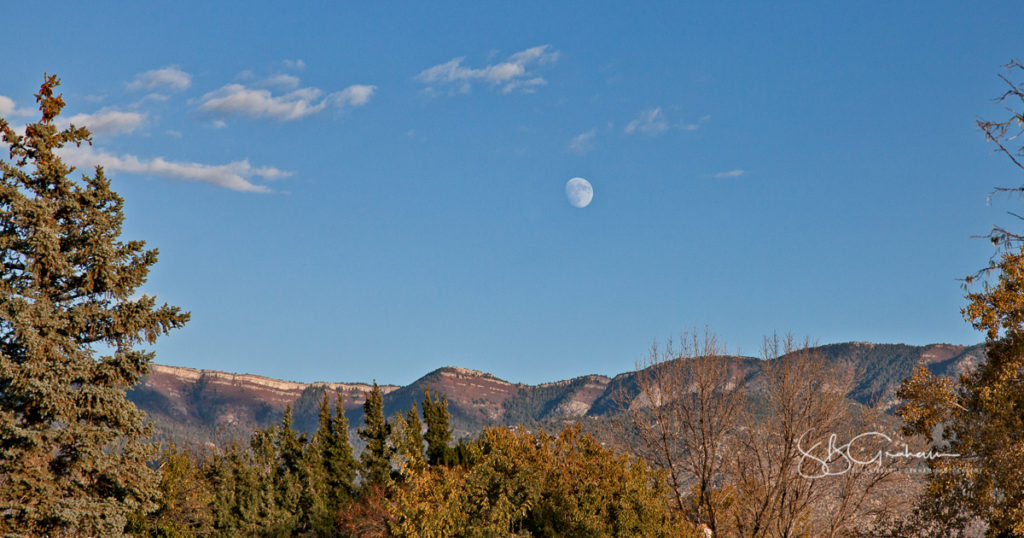
Moon and Jupiter are among the brightest objects we see in the night sky. The rising sun, with its brightness, washes them out. Just before sunrise on October 28, 2016, they appeared close together.
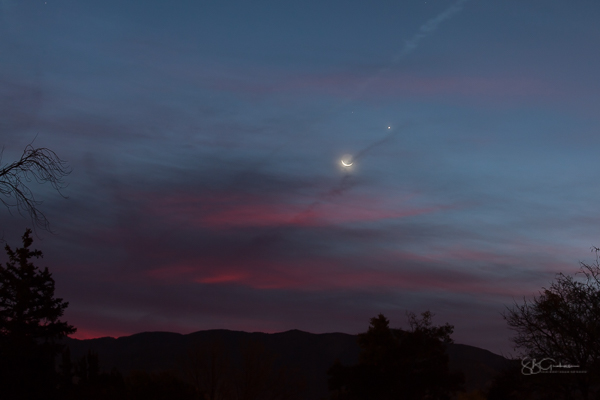
The skies here in Albuquerque have been clear at sunrise recently, and I have missed the colors. Today, at first, though, I was a little disappointed to see the moon and stars somewhat obscured by light clouds. As the sun began to rise, however, I was delighted to see the reds, oranges, and blues develop above the silhouetted Sandia Mountains.
I have much clearer images of the alignment of Venus, Jupiter, and Mars from several months ago than of today’s phenomenon. But for sheer beauty, at least to my eye, I’ll take today’s pre-dawn Albuquerque sky.
Crepuscular rays of light, “fingers of God,” and other names are beautiful atmospheric optics. August 2016 has been remarkable for their appearance over the Sandia Mountains. I’ve been able to photograph this phenomenon at sunrise twice in less than a week. Of note, many images on the internet were taken at sunset rather than sunrise, and the rays will appear pointing down. (The rays are actually parallel, but that is another discussion.)
This was the first. It was the most dramatic example I have personally ever seen.
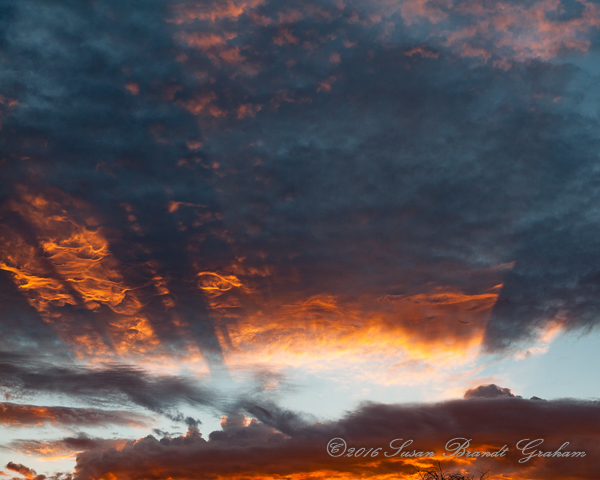
This is the second. This sunrise was more typical. The rays and sky were “gentle.”
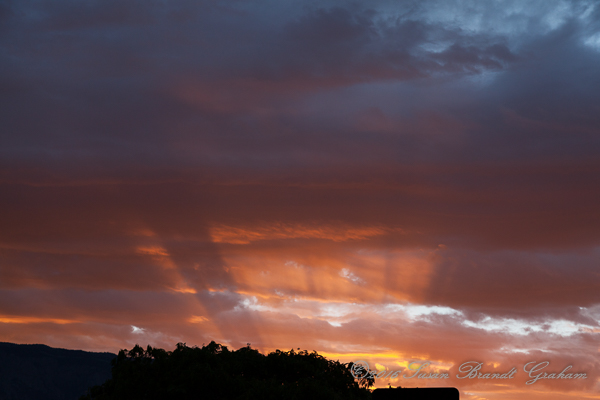
Phenomena like this do not last long. Within two minutes, the rays were almost gone.
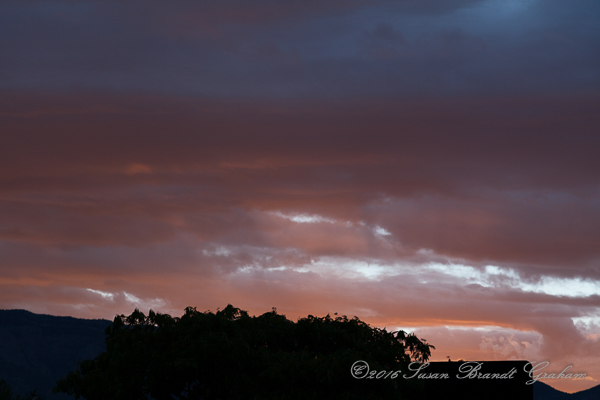
Note that the days are getting shorter. Compare the time of the first image to the time of the second image, just a few days later.
Photographers in Albuquerque know the skies during monsoon season may present even more wonderful opportunities than usual. Many of us remember the summer of 2009 as being full of marvelous skies. This year, friends are capturing amazing images of the lightning storms we have had recently. Sunrises, which I have enjoyed for many years, are proving to be even more remarkable to me this monsoon season of 2016.
Edited to add: Added bonus: a rainbow to the west a little later in the morning!
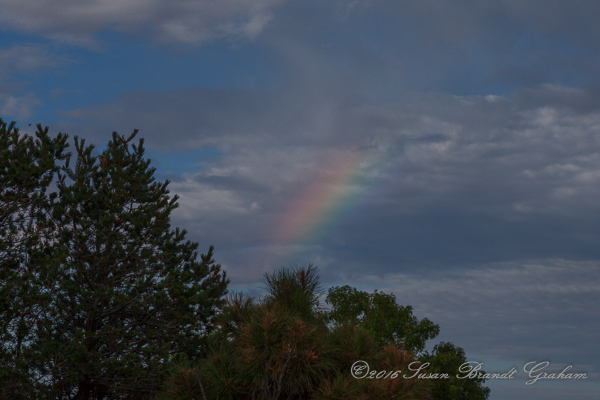
Monsoon light makes for some remarkable skies here in the high desert. The rain is always welcome. That is especially true this year, which has been very dry to this point. Monsoon season seems to have finally arrived, with heavy rain in some parts of Albuquerque two nights ago and an inch of rain at my house last night. Photographer friends here in Albuquerque remember the monsoon skies of 2009. 2016 may be remembered for its rainbows. Albuquerque has a reputation of sorts for its rainbows, especially the double ones. This has been a great year for rainbows!
Two nights ago I photographed a striking, although single, rainbow. I knew it would develop because of the special monsoon light that appeared as the clouds cleared from the west, with heavy clouds to the east. Anyone who has been here for any length of time and has watched the skies at all knows what this looks like.
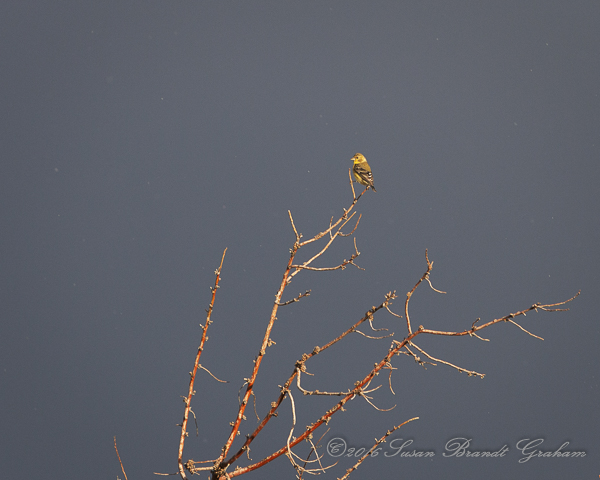
7:17pm, MDT. Sun breaking through storm clouds to the west lit this little goldfinch and the branches of a neighbor’s tree dead from the prolonged drought. Heavy, dark clouds covered the mountains to the east. This is the set-up for a rainbow here in Albuquerque. The little spots are not dust on the sensor, but light reflecting off very light drizzle falling at the time.
7:19pm, MDT. A very faint rainbow appeared.
By 7:25pm MDT a magnificent, full arc rainbow had completely developed, persisting for some time.
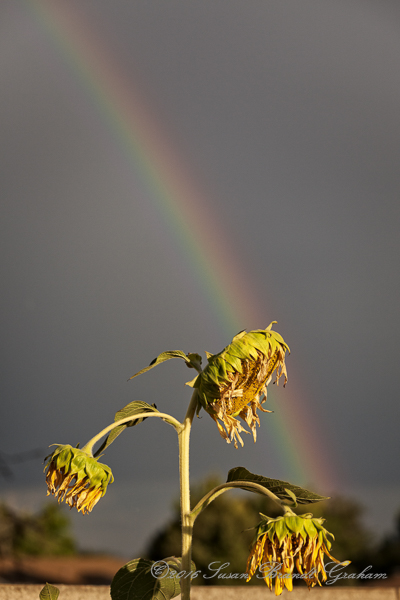
I chose this particular evening to focus on the interplay of the monsoon light with things I enjoy in my yard. The large sunflowers are almost ripe with seeds for the birds. This image seems to speak to people with a variety of different beliefs about the cycle of life, with the fading sunflowers that will soon provide nourishment for the birds, and the rainbow, a symbol of hope for people of many different beliefs.
Monsoon light – just one more reason I love living in the high desert of New Mexico.
A dramatic sunset, that appears to be stormy. The afternoon and evening were actually quite calm. In this case, looks were a bit deceiving.
The sun has clearly moved farther north, as we approach the equinox.
